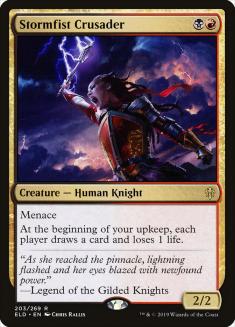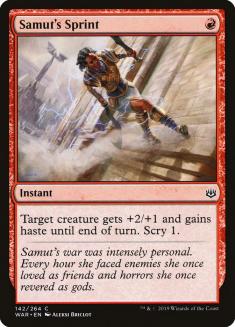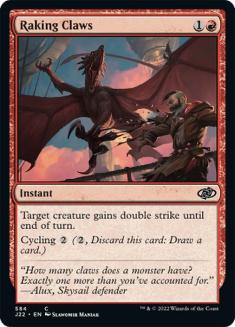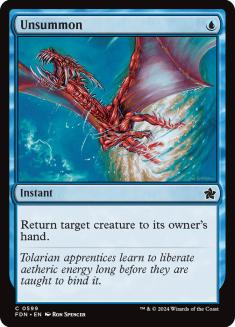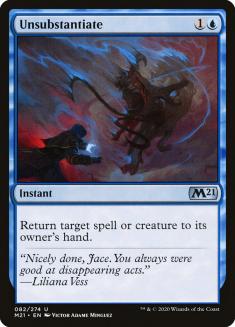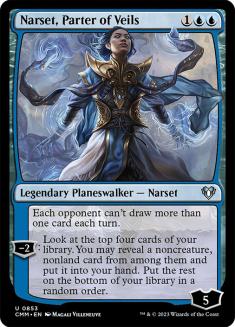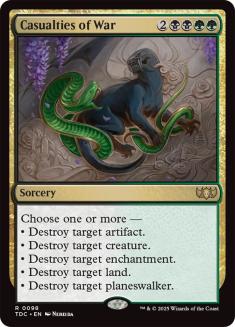This past weekend, after far too long of an absence, I made my return to the SCG Tour booth and provided coverage of the most recent SCG Tour Online Championship Qualifier alongside Michael Majors. It felt good to do something that vaguely resembled my pre-pandemic routine. It’s going to be a long time until life approaches normalcy but wrapping myself up in the flow of the event and the stories it developed turned out to be precisely the right form of escapism. Beyond the personal impact, a day of quality matches left me feeling decent about the state of Core Set 2021 Standard, despite what appeared on paper to be a very problematic Top 4.
I’ve long said that working in a commentary role provides an understanding of an event that is challenging to achieve as a participant. Commentators soak up a lot of Magic with a lot of different decks, get to eavesdrop on the broader player experience, and free themselves from the narrative of a single social circle or playtest team.
Obviously, some of this disappears in the context of the online tournament. To start with, the SCG Tour Online is a much smaller tournament than traditional Opens. You can’t stroll through the digital tables and find the sideboard card that blew up overnight. You can’t pop into DMs to find everyone talking about the incredible new deck that a testing team has found. You can’t pick players brains after a match to understand choices in deckbuilding and play.
This is a big shift, and I was somewhat concerned that the experience of calling an online tournament from the comfort of my office would be a little hollow. I’m happy to report that this was not the case. I felt like I left my coverage role this weekend with a lot of new insight. Here are my three biggest takeaways from this past weekend.
Arena is a Whole Different Ballgame
This point is a bit meta, so bear with me on this one. I promise we’re getting to the information that is going to win you games of Magic in just a few minutes. If you care about the future of Magic and Magic tournaments though, I think you should have at least some passing interest in how those events are presented as entertainment products.
I’ve been broadcasting Magic for about a year-and-a-half now, but this was my first crack at an event on Arena. I was shocked at how dramatically the platform altered my job. When I’m in the booth, I typically take on the play-by-play role. This means it’s my job to provide clarity to the viewer, reinforce the narratives present, and set up my color commentator with opportunities to provide details and insight.
When I’m calling a match of paper Magic, a large portion of my effort is expended on creating the tone and atmosphere for the match and making sure the viewer is able to clearly understand and interpret the actions of the players. Even for experienced Magic players, tracking cards in players hands, discerning targets, and something as simple as knowing what phase of who’s turn we are in are all huge expenditures of mental energy that can take away from enjoyment of the product.
Competitive paper Magic is on hiatus, but it’s not going away. It has so many unique aspects as both a participant and a viewer that it will never be full subsumed by Arena.
I’ve always thought the closest real-sport analogue to my role is “radio baseball play-by-play broadcaster.” Get the info across, and provide a soothing, comfortable, enjoyable routine for a viewer to be able to settle into. It’s why you hear me announce things like an untap or draw step. It’s about creating a recognizable cadence. “Here’s the windup… and the pitch.”
Arena is not the same game. For the most part, all of the miniscule details are tracked by the program. In addition, the pace of routine actions is dramatically accelerated. Untapping and drawing are no longer callable actions. They’re just things that happen.
This meant I had to adapt my usual approach on the fly, and I settled into a role that was about 70% play-by-play and 30% co-color commentator. This required me to really shift my focus and pay more attention to the strategic implications of every decision. Not to say this is absent in paper, but in general, if I have to drop the thread of high-level gameplay and rely on my color commentator to pick it back up, I’m comfortable doing so when it allows me to really provide game state clarity.
This new approach allowed Majors and I the opportunity to get into some quality discussions about broader Magic strategy and the nuances of the present Standard metagame. There’s a lot that has been said about the accessibility of Arena for less experienced audiences, but the platform can be just as much of a boon for the experienced viewer if commentary teams use the freed up time and brainpower to delve into finer details. This shift speaks to the importance of having a solid strategic hand in the play-by-play slot, and I came away with a lot of respect for all the folks who have been doing the job in the Arena era. It has changed a lot, and it’s not easy.
For all the clarity benefits that Arena does provide, there are some odd quirks. There are elements of the display which are only visible at certain times. For instance, early in the day I learned it was challenging to immediately recognize the decisions being made to fuel Uro, Titan of Nature’s Wrath’s escape costs without reliable access to the number of cards in graveyards. Normally a paper player acting on that information will reach for their graveyard and take an opportunity to count cards, and I can count along with them. There was also a point where Majors and I both blanked on Stormfist Crusader’s menace ability where seeing its full textbox on screen might have reminded us. The client would benefit massively from an observer mode, and trying to position Arena as the core of organized play without this functionality is a real oversight.
Also missing was a lot of the natural human emotion that so often informs the narrative of a paper match. I did miss being able to read a player’s face for anger, relief, and jubilation. It’s a lot of what makes the act of watching a Magic tournament so emotionally resonant. We’ve been in similar spots, and we can picture what the players are going through. Unfortunately, this is just one of the realities of our present circumstances. A webcam/streaming requirement doesn’t strike me as realistic and would add a lot of hurdles from the production side.
My main purpose in sharing all of this with you is presenting this one conclusion: competitive paper Magic is on hiatus, but it’s not going away. It has so many unique aspects as both a participant and a viewer that it will never be full subsumed by Arena. Arena and paper Magic are two different things. When people say they love one and don’t care about the other, I don’t agree, but I see where they are coming from. Just because the games have the same core doesn’t mean you can hand wave away the real and substantial differences. Calling a weekend of Arena games really drove home that point for me. I had a blast and learned a ton. I’m looking forward to continuing to improve as an Arena broadcaster. But I also can’t wait to call a match of paper Magic again.
The Izzet Decks Are Getting Close
Creatures (15)
Lands (20)
Spells (25)

Creatures (14)
Planeswalkers (1)
Lands (17)
Spells (25)
Sideboard

I’ve said it from Day 1 of this new Standard format: Izzet decks must find a reason to justify their existence. Simply functioning as a worse control or worse aggro deck than other available options will never get the job done. Finally, it seems players are starting to carve out an identity for Izzet.
First, these decks have increased the aggression quotient by a significant margin over early Izzet decks. Samut’s Sprint and Raking Claws are not what I’d call good cards by any stretch, but these decks understand that the late-game of Sultai Ramp is putting a limit on your realistic window to win the game. The creature selections of Riddleform and Stormwing Entity are choices that maximize aggression in best case scenarios, and Riddleform gets some bonus points for its ability to provide insurance against the widely played Extinction Event.
Moving on from aggression, it feels like we are finally honing in on the right tempo tools as well. Unsummon was underappreciated early on in Izzet decks, but as converted mana costs creep upwards, the card shows more and more promise. Abe’s choice of Unsubstantiate as maindeck countermagic of choice is an inspired one, and playing a card like that solidly identifies the turns in which this deck is trying to win. We’re squarely at the point of a maindeck Aether Gust format though, and if you can get that upgrade in card quality, I’d urge you to take it like Arevalo did.
Sideboard cards for both players really looked to hard exploit Sultai Ramp’s two-mana removal by routinely gaining mana advantage from multiple copies of Miscast. Meanwhile, Narset, Parter of Veils put a fork into late-game Hydroid Krasis. I also really like Arevalo’s three copies of Whirlwind Denial for the same purpose. If Sultai’s average converted mana cost is going to float high enough, looking for the best three-mana counterspells becomes viable as well.
Izzet Aggro put up some real results this weekend, despite very limited representation. However, in actually watching the games Abe played, I saw a real consistency problem. I know we’ve played plenty of twenty land decks in the past, but in the Modern era of Magic, playing these types of mana ratios feels like leaving everything to chance. I am begging for a twenty-first land here. At the same time, I think both of these Izzet Aggro decks were wonderfully built to punish the more stock Sultai Ramp lists coming into this weekend. After Alexander Gordon-Brown’s performance, you can officially consider those old Sultai Ramp lists outdated.
AGB’s Win Changed the Face of Sultai Ramp
Creatures (11)
Planeswalkers (4)
Lands (27)
Spells (18)
- 2 Negate
- 1 Disdainful Stroke
- 4 Thought Erasure
- 4 Aether Gust
- 2 Mystical Dispute
- 2 Eat to Extinction
- 3 Shark Typhoon
Sideboard

I’ve gushed about Alexander’s decklist on every conceivable platform at this point. It really was a special piece of deckbuilding that addressed almost all my complaints about existing Sultai Ramp lists. It successfully applies the big brained 2020 strategy of “play all the good cards” with four copies each of Hydroid Krasis; Nissa, Who Shakes the World; and Uro, Titan of Nature’s Wrath. I’d argue it carries this principle even further by picking up copies of Brazen Borrower and Shark Typhoon — two more cards that have shown themselves to have Legacy-level power.
It takes Thought Erasure — a card I despised in other Sultai Ramp builds — and uses it not as its main form of disruption, but as a bridge to the actual meaningful interaction that’s capable of generating the mana advantages so critical in the mirror. Four maindeck copies of Aether Gust, alongside Disdainful Stroke, Mystical Dispute, and Negate filled this role admirably. Speaking of cards I despised, zero copies of Casualties of War! Finally!
Even the decision to move to Eat to Extinction shows Gordon-Brown’s intense focus on the mirror. “Mitigate Nissa and figure out the rest from there” makes perfect sense. And having ceded so much ground elsewhere, Gordon-Brown absolutely stocked the sideboard against aggro. Pretty decent call in tournament comprised of 38% Sultai Ramp decks that had a 60% win-rate and comprised 75% of the Top 8.
The focus will rightfully be on Gordon-Brown’s list going into this weekend, but it’s worth taking a look at Koutarou Ishibashi’s second place list as well.
Creatures (6)
Planeswalkers (8)
Lands (28)
Spells (18)
- 4 Thought Erasure
- 1 Casualties of War
- 3 Aether Gust
- 2 Mystical Dispute
- 3 Shark Typhoon
- 2 Extinction Event
- 3 Eliminate
Sideboard

There are real similarities between these two decks. Both players shifted hard to stack-based interaction, but Ishibashi slanted further to the control role unlike Gordon-Brown’s almost flash like approach. It’s possible Ishibashi achieved much of what Gordon-Brown did in the mirror without giving up as much equity against the aggro lists. Ishibashi just had the misfortune to run into a stone mirror-killer in the finals. I don’t think you can really go wrong with copy-pasting either of these lists for this weekend, but both players illustrated a critical point.
A lot of the Sultai Ramp lists in this tournament felt like carbon copies of lists from the prior week, with a small sideboard alteration or two. We’re suffering a hangover from months of the best deck and best builds being obvious. Trust me, I was right there with everyone else jamming slightly tweaked Jeskai Lukka (Yorion) and Temur Reclamation lists week in and week out and being positive I was very close to correct.
That’s not the world we’re in now though. New configurations of Sultai Ramp were rewarded this weekend, and metagame churn is finally starting to happen, even if it’s just in flavors of Sultai Ramp. There’s no question that the core of Uro, Hydroid Krasis, and Nissa is the strongest thing in the format. But these cards do have exploitable weaknesses and even if you reach the conclusion that they are simply too strong not to play, your support squad needs to be up for constant review. Let’s see if an aggro deck sufficiently punishes new Sultai’s lack of spot removal and sweepers, or if Sultai can shift again to move even further ahead of the field.




